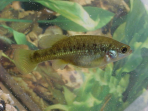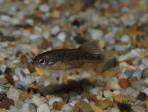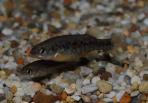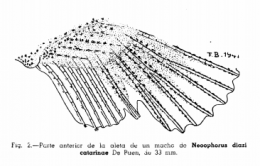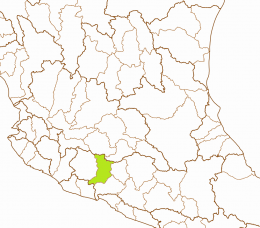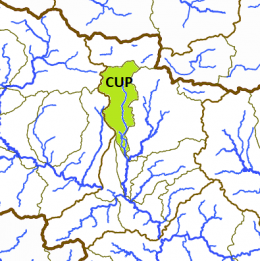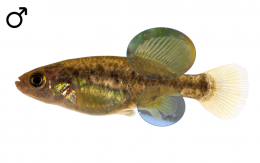- HOME
- WHO WE ARE
- NEWS AND DATES
- GOODEIDS
- PHYLOGENY
- ARTIFICIAL KEY
- GOODEID SPECIES
- BIOLOGY
- ENVIRONMENT
- CONSERVATION
- PROFUNDULIDS
- MEMBERS AREA
Allotoca catarinae
English Name:
Catarina Allotoca
Mexican Name:
Tiro Catarina
Original Description:
DE BUEN, F. (1942): Una nueva subespecie del Neoophorus diazi (Meek). Anales del Instituto de Biologia. No 13(1): pp 341-349
Holotype:
Fernando de Buen didn't deposit types, so there is no Holotype and no collection number for this species available. He wrote in the description of his new subspecies, that the fish had been collected on August the 11th and 12th, 1941 by fishermen of the limnological station of the town of Pátzcuaro (Estación Limnológica de Pátzcuaro). A figur in his paper shows a female, another one the andropodium of a male. Several females of total lengths between 20 and 61mm were collected as well as males between 26 and 36mm, but the total number of specimens is not presented in his paper.
The left picture shows a female of Allotoca catarinae, the right one an andropodium. Both drawings from the description of de Buen.
Terra typica:
Etymology:
The species is named for the type-locality, the Presa Catarina in Uruapan, Michoacán.
The genus Allotoca was erected by Hubbs and Turner, published by Turner in 1937 and taken from the manuscript of the famous monography about Goodeids that Hubbs & Turner finally published together in 1939. Though the authors mentioned the posterior insertion of the dorsal fin, "the more fundamental characters of Allotoca, however, are ovarian and trophotenial..." The word ἄλλος (állos) means different and τόκος (tókos) offspring, so the genus refers to the different looking trophotaenia of the fry with the generic name meaning "different offspring".
Synonyms:
Neoophorus diazi Hubbs & Turner, 1939 (partially)
Neoophorus diazi catarinae de Buen, 1942
Neoophorus catarinae Álvarez del Villar, 1959
Distribution and ESU's:
The Catarina Allotoca is endemic to the Mexican federal state of Michoacán. It inhabits the Río San Antonio (Río Santa Bárbara or Río Santa Catarina), an affluent of the Río Cupatitzio, from the spring of this river above the Presa Catarina (Presa Caltzontzín) downstream, and after its junction with the Río Cupatitzio in this river downstream with the last known location site about 500m S of the Presa Cupatitzio. The Río Cupatitzio itself is an affluent of the Río El Marqués, an affluent of the Río Tepalcatepec, which is the western tributary to the Río Balsas, so the species belongs to the fish fauna of the Río Balsas drainage. Affiliated to its occurence in only one river system, no subpopulations are distinguished. The bold names are the ones officially used by the Instituto Nacional de Estadística y Geografía, nevertheless, other ones might be more often in use or better known and therefore prefered.
ESU ist short for Evolutionarily Significant Unit. Each unit expresses an isolated population with different genetic characteristics within one species. ESU's can be defined by Molecular genetics, Morphology and/or Zoogeography and help in indicating different phylogenetic lineages within a species. The abbreviation for an ESU is composed of three letters of the genus, followed by the first two letters of the species name and an ongoing number in each species.
In Allotoca catarinae, no ESU's are distinguished, so all populations belong to Alcat1.
The left map shows the Río Tepalcatepec-Infiernillo basin from the Hydrographic Region Balsas on a Mexico map. Within the Río Tepalcatepec-Infiernillo basin, the Catarina Allotoca occurs only in the Río Cupatitzio subbasin (CUP), shown on the right map:
Status :
International Union for Conservation of Nature (IUCN): Critically Endangered
Distribution and current conservation status of the Mexican Goodeidae (Lyons et al., 2019): Vulnerable/stable: „This species is known from approximately ten locations in the upper Cupatitzio River drainage in the upper Balsas River basin near the city of Uruapan and possibly also in the Lake Cuitzeo/Grande de Morelia and Lake Pátzcuaro basins, although the taxonomic status of specimens from outside of the Cupatitzio River drainage is uncertain (Doadrio and Domínguez-Domínguez, 2004). None of these populations are particularly large, but all have persisted since 2000. This species is genetically very similar to A. diazi and may have reached the upper Balsas basin by a human transfer within the last 1,000 years (Corona-Santiago et al., 2015).“
NOM-059-SEMARNAT-2010: Categoría de riesgo (Category of risk): P - En Peligro de Extinción (in danger of extinction)
Habitat:
The habitats are moderately sized streams and reservoirs in clear water over substrates of rocks, sand, mud and silt. It prefers densely packed submergent plant stands in depths of less than 1m.
During a survey in 2017, the GWG documented this species from the upper part of the Presa Catarina. Here a narrow path over a wall dams the spring creek up to a 20 x 30m shallow pool and separates it from the rest of the Presa with a passage in the middle. Another wall is on top of this pool, leavig a passage for the moderatly fast flowing creek. Fish could be found on both sides of this little dam. The water was about 50cm deep, the ground made up of silt, mud and sand, with almost evenly distributed rocks and boulders. Those rocks were densily covered with green filamentous and short brown algae and aufwuchs. The shore was partly made up of riparian grass, partly building up dense vegetation growing in the shallow water or hanging over the surface. The habitat was partly shaded by huge willow trees (Salix sp.). Allotoca catarinae was mainly hiding between the rocks or more often in the vegetation. The only other fish at this collection site was another Goodeid species, Ilyodon whitei.
Biology:
Fernando de Buen isolated thirteen 12.5mm long embryos from a 53mm (TL) female. This species may have a long reproduction period because pregnant females were caught in late February and mid-April. De Buen observed in 1942 embryos in the first half of August.
On the so far only survey to the Presa Caltzontzín in March 2017, no gravid females were found.
Diet:
This species is said to feed on aufwuchs and detrital material sifted from bottom silt. However, looking at the dentition, form and size of mouth as well, it is more likely that this species - like its congeners - feeds mainly on small insect larvae, shrimps, water fleas and worms.
Size:
The maximum known standard length is about 70mm (Miller et al., 2005).
Colouration:
De Buen described the colour of the females (preserved in formol) as dark on the dorsal part, pale on venter, cheek and nape. Dorsal, caudal and pectoral fins are tenderly shaded, ventral and anal fins generally clear. Even if there is a variable colouration on the flanks, no specimen shows elongated, transversal blotches or distinct vertical bands. Young females of 20 to 24mm are irregular mottled; near 30mm, the colour changes into a uniformity, showing a trace of a dark longitudinal band in some individuals. In bigger females, the irregular blotches and spots become more and denser, giving some females even a nearly uniform grey appearance, only on the caudal peduncle, there can be seen a certain tendency to form vertical traces through association of spots. Though de Buen obviously had also males for the description, he only mentioned the small size (up to 36mm), but did not give any definition of the colouration.
Sexual Dimorphism:
At first appearance, males and females of the Catarina Allotoca are not very easy to distinguish. The safest characteristic is the Splitfin in males, means the for Goodeinae typical mating organ formed by a notch after the first seven shortened rays of the Anal fin. Additionally, male Allotoca catarinae have a bigger Dorsal fin than females. A difference in colouration is almost not visible, except for a sometimes yellowish Anal fin in females. Females are a bit longer than males with a bigger and blunt head, but some experience is necessary to see these characters.
Remarks:
Already in 1939, Hubbs and Turner examined specimens, caught from H. M. Smith in "a lake near Uruapan" and found differentiating characters and a distant colour-pattern to the fish described by Meek as Zoogoneticus diazi. A few years after the subspecies-description by de Buen, Álvarez del Villar found these characters strong enough to lift it into specific rank.
As a reaction on the threats this species is facing, the Austrian Association of Aquarists (ÖVVÖ) started a Studbook on this and all other Allotoca species (including the closely related Neoophorus regalis).
A theory of Corona-Santiago suggests, that Allotoca catarinae was originally not living in the Río Cupatitzio system, but brought there from the surrounding area as part of a kind of fertility rite by indigenous people. He sees this theory supported by the sympatric existence with Alloophorus robustus. Following his opinion, the mountain range northeast of Uruapan is isolating the area of the city from the Pátzcuaro basin for such a so long time, that the ancestors of catarinae may have never reached the upper Río Cupatitzio drainage. An interesting and adventurously sounding theory, and absolutely worth to think about it. On the other hand, the Catarina Allotoca is distinct from Allotoca diazi and meeki, its closest relatives when comparing cytochrome genes, and it is in colour pattern and shape more similar with the in the north living Allotoca zacapuensis, so the relationship is not completely solved. A natural occurence of both species, Allotoca catarina and Alloophorus robustus, in the drainage is easily conceavable. One important fact discounting this theory is that the Bulldog Goodeid in the Río Cupatitzio drainage is closer related with representatives from the Cotija area or the Lower Lerma than with fish from the - geographically closer - Pátzcuaro lake drainage, where the ancestors of Allotoca catarinae should come from. So why is there not the Bulldog Splitfin from this lake? A situation, that is easier to explain by natural stream capture than by human introduction. Additionally, and not easily explainable when introduction was the reason for Allotoca catarinae occupying this river, is that no other Goodeid species from the Pátzcuaro lake basin or the Río Lerma drainage occur in the Río Cupatitzio system. The only other Goodeid is Ilyodon whitei, a typical species from the Río Balsas drainage, where the Río Cupatitzio belongs to. It is not very likely, that the species brought to the drainage would have been specifically selected; it would have been in contrary a mix of all existing species and we should still be able to find at least some of them. An alternative theory from Álvarez del Villar (1946) talks about an ancient river connecting the Cuitzeo, Pátzcuaro, Zirahuén and Uruapan areas.
There exist samples from an Allotoca diazi like species from the endorheic Lago de Cuitzeo basin, more precisely from the La Mintzita spring and the Presa de Cointzio, sometimes refered to as Allotoca catarinae. Unfortunately all of these are historic records, so we haven't found any similar looking species in the last decades, and it is also not clear, if these samplings were really made in the area and if yes, which species they belong to. Allotoca catarinae would have been isolated from the Uruapan area by the presence of Allotoca diazi in the area of the Pátzcuaro lake, which makes it quite unlikely (unless the theory explained above is true, so a human transfer might have happened).
Husbandry:
Looking on the biotopes of Allotoca catarinae, they suggest the species may prefer a habitat with moderate to swift current, structured with gravel, rocks, roots, branches, fallen leaves and river bank vegetation. Fry is eaten in some cases, but it may depend on the quantity and quality of food and on the number of places to hide. When several different stages of juveniles occur, fry may be neglected, so it makes sense to add separate brought up fry to the group with a size of 1.5 or 2cm to provide these stages and get a flock breeding colony.
The recommended tank size is at least 100 liters, bigger tanks with a generous base and little height (25cm are enough) are better for sure. With rocks and vegetation in the corners and backside of the tank well structured tanks combined with some roots and/or wood seem to do best with this species. The current should be moderate or swift, especially as the species is adapted to a high oxygene level (at least 8mg/l).
In the wild, the species feeds mainly from small or middle-sized invertebrates like bloodworms or insect larvae, so feeding with similar food, water fleas, Mysids and other food from animalistic sources will be best for this predatory fish. In aquarium, it feeds also well from flake food, granulate and even tablets, additionally given Nauplia of Brine Shrimps are eaten greedy. The species is acting a bit shy.
Concerning water quality, this species is in need of bigger water changes (60-80% every week) like most of the Goodeids, especially river and spring inhabiting species, so an automatic water changing system can be helpful. Otherwise, in combination with constant temperatures higher than 24°C, fish may get sick, lose resistance against diseases and age too fast. So for keeping the strain healthy and strong, give the fish a rest during winter time with temperatures lower than 20°C for 2 or 3 months so they stop producing fry. Allotoca species can be kept down to temperatures of 15-16°C without problems for months, some species even lower. In spring, when the temperature slowly increases, they will start spawning at 20 or 21°C and won't stop until it gets colder again or when it gets too warm (25°C).
This species is doing very well when is kept in the open from spring to fall, starting when the water temperature by day exceeds 15°C and cold periods are no longer expected. Bring them out in the early afternoon, the time of the day with the highest water temperature. During the warm summer, reproduction will stop and may occur again in fall. Bring the fish in before the water temperature deceeds 15°C by day and keep them cool for the first days, then slowly raise the temperature but try to stay below 20°C over the winter time.
Populations in holding:
Here each species are assigned populations of fish in husbandry and in brackets aliases of these locations to assist in identifying own stocks. Each population is assigned a unique Population-ID, composed by the ESU, the subbasin where this population is occurring (three capital letters) and a unique location identifier.
Populations in holding:
1. Altca1-CUP-Urua
Population: Uruapan (aka Río Santa Barbara, El Saúco, Presa Caltzontzín)
Hydrographic region: Balsas
Basin: Río Tepalcatepec-Infiernillo
Subbasin: Río Cupatitzio
Localities: Presa Caltzontzín and area El Saúco 0.6km downstreams beeline


